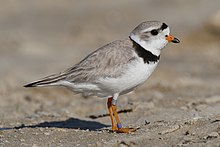
Back زقزاق شادي Arabic زقزاق شادى ARZ Charadrius melodus Bulgarian Corriol xiulador Catalan Charadrius melodus CEB Cwtiad chwibanol Welsh Flötenregenpfeifer German Charadrius melodus Spanish Charadrius melodus Basque سلیم پازرد Persian
| Piping plover | |
|---|---|

| |
| Sauble Beach, Ontario, Canada | |
| Scientific classification | |
| Domain: | Eukaryota |
| Kingdom: | Animalia |
| Phylum: | Chordata |
| Class: | Aves |
| Order: | Charadriiformes |
| Family: | Charadriidae |
| Genus: | Charadrius |
| Species: | C. melodus
|
| Binomial name | |
| Charadrius melodus Ord, 1824
| |
| Subspecies | |
| |

| |
The piping plover (Charadrius melodus) is a small sand-colored, sparrow-sized shorebird that nests and feeds along coastal sand and gravel beaches in North America. The adult has yellow-orange-red legs, a black band across the forehead from eye to eye, and a black stripe running along the breast line. This chest band is usually thicker in males during the breeding season, and it is the only reliable way to tell the sexes apart. The bird is difficult to see when it is standing still, as it blends well with open, sandy beach habitats. It typically runs in short, quick spurts and then stops.
There are two subspecies of piping plovers: the eastern population is known as Charadrius melodus melodus and the mid-west population is known as C. m. circumcinctus. The bird's name is derived from its plaintive bell-like whistles which are often heard before the bird is visible.
In 1986, the U.S. Fish & Wildlife Service listed the Great Lakes population as endangered and the Northern Great Plains and Atlantic populations as threatened.[3] Intensive conservation efforts have yielded slow population growth, but only some populations have met the recovery goals set for them.[4] The growth trend is expected to reverse if conservation efforts were stopped.[5] Total population was estimated to be between 7600 and 8400 individuals in 2020.[6]
Their breeding habitat includes beaches and sand flats on the Atlantic coast, the shores of the Great Lakes, and in the mid-west of Canada and the United States. They nest on sandy or gravel beaches or shoals.[7] These shorebirds forage for food on beaches, usually by sight, moving across the beaches in short bursts. Generally, piping plovers will forage for food around the high tide wrack zone and along the water's edge. They eat mainly insects, marine worms, and crustaceans.
- ^ BirdLife International (2020). "Charadrius melodus". IUCN Red List of Threatened Species. 2020: e.T22693811A182083944. doi:10.2305/IUCN.UK.2020-3.RLTS.T22693811A182083944.en. Retrieved 12 November 2021.
- ^ NatureServe (5 May 2023). "Charadrius melodus". NatureServe Network Biodiversity Location Data accessed through NatureServe Explorer. Arlington, Virginia: NatureServe. Retrieved 25 May 2023.
- ^ "USFWS: Piping Plover Fact Sheet". www.fws.gov. Retrieved 2021-06-27.
- ^ Weithman, Chelsea E; Robinson, Samantha G; Hunt, Kelsi L; Altman, Jon; Bellman, Henrietta A; DeRose-Wilson, Audrey L; Walker, Katie M; Fraser, James D; Karpanty, Sarah M; Catlin, Daniel H (3 August 2019). "Growth of two Atlantic Coast Piping Plover populations". The Condor. 121 (3). doi:10.1093/condor/duz037.
- ^ "Piping Plover (Charadrius melodus) - BirdLife species factsheet". datazone.birdlife.org. Retrieved 2021-06-27.
- ^ "Piping Plover (Charadrius melodus)". IUCN Red List. Retrieved 17 June 2023.
- ^ Zeigler, Sara L.; Catlin, Daniel H.; Brown, Mary Bomberger; Fraser, James D.; Dinan, Lauren R.; Hunt, Kelsi L.; Jorgensen, Joel G.; Karpanty, Sarah M. (11 January 2017). "Effects of climate change and anthropogenic modification on a disturbance-dependent species in a large riverine system". Ecosphere. 8 (1): e01653. Bibcode:2017Ecosp...8E1653Z. doi:10.1002/ecs2.1653. hdl:10919/89387.

